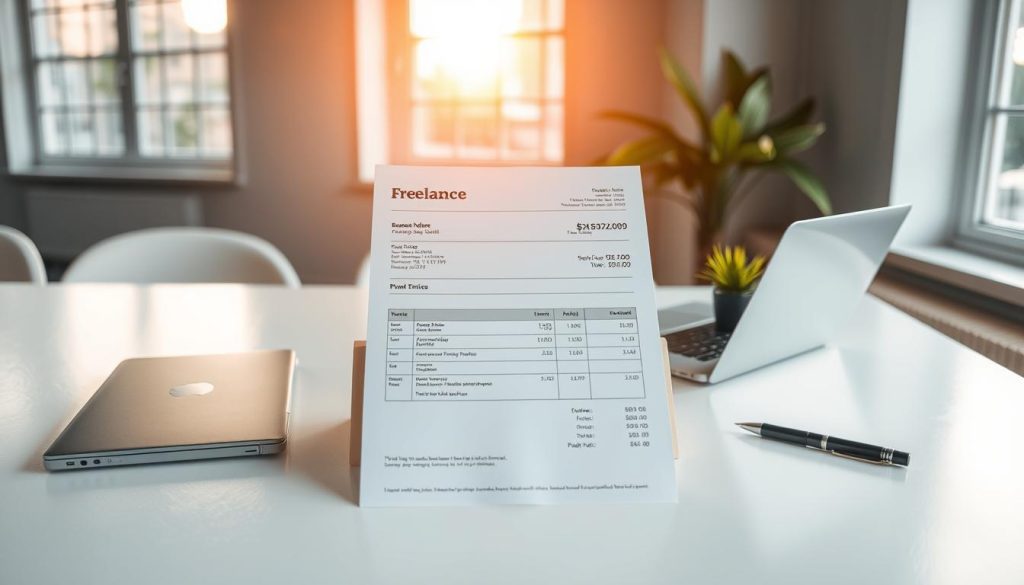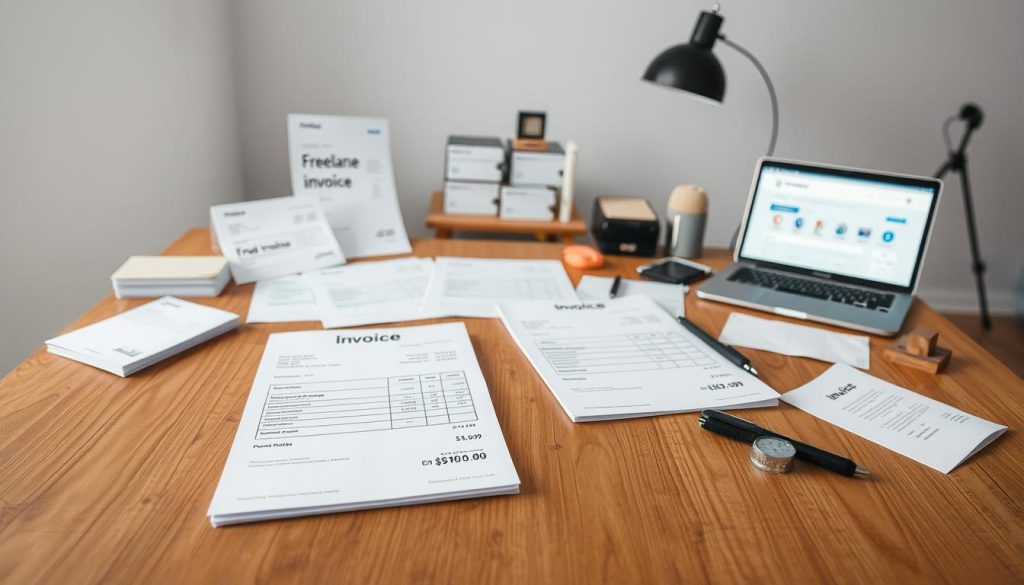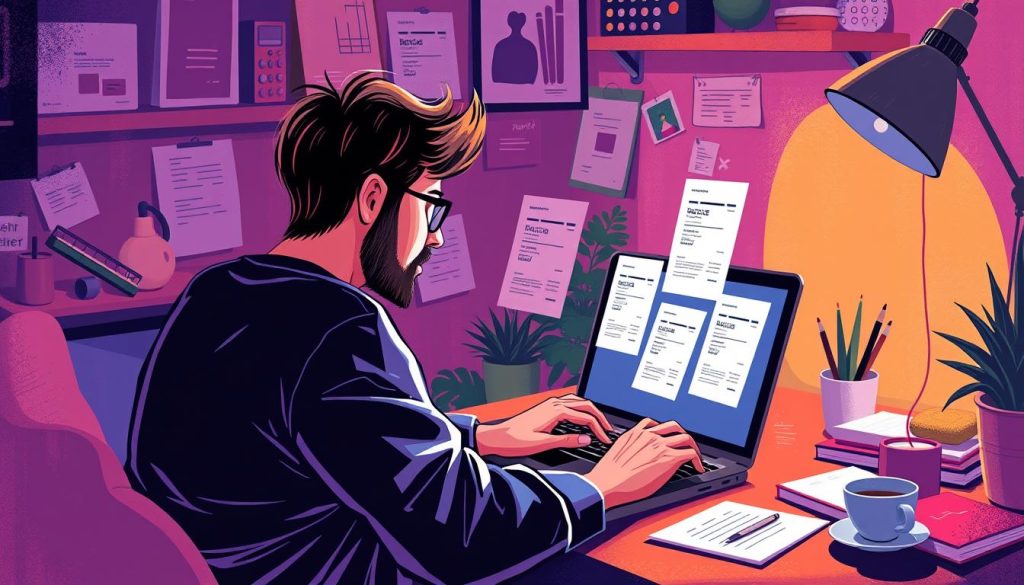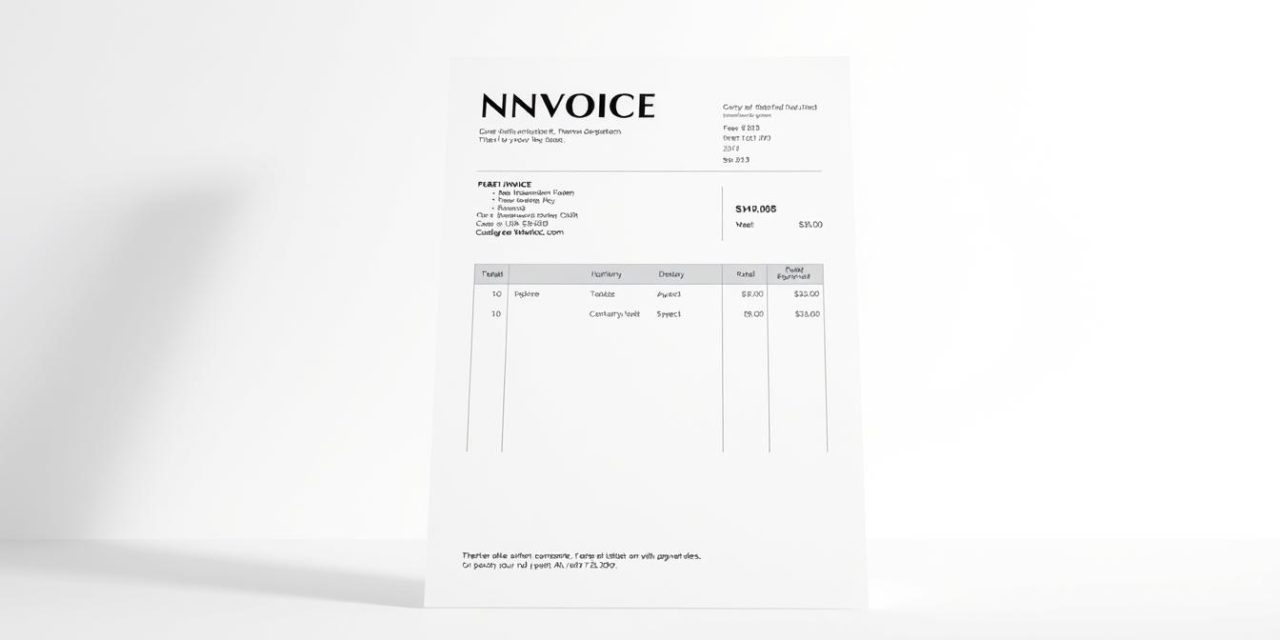Approximately 74% of independent professionals experience late payments, which can significantly impact their cash flow and business credibility. Proper invoicing is crucial to mitigate this risk and ensure timely payments from clients.
Failing to send a polished invoice can send the wrong message to clients: that you’re not serious about your work or business. On the other hand, a well-crafted invoice can enhance your professional image and facilitate smooth payment processes.
Effective invoicing is not just about getting paid; it’s also about maintaining a healthy business relationship with your clients. By using the right tools and best practices, you can streamline your invoicing process and focus on growing your business.
Table of Contents
Key Takeaways
- Understand the essential elements required on a professional invoice.
- Learn how to create invoices that help you get paid on time.
- Discover best practices for maintaining professional relationships with clients through effective invoicing.
- Explore different types of invoices for various situations.
- Get practical advice on setting up efficient invoicing systems and tracking payments.
Why Professional Invoicing Matters for Freelancers
Professional invoicing is not just about getting paid; it’s about establishing credibility with your clients. As a freelancer, your invoice is often the last touchpoint in a project, and it leaves a lasting impression on your client.
A well-designed invoice not only requests payment but also reinforces your professional image. It demonstrates that you are serious about your business and helps clients see the value in your work and services.
Building Credibility with Clients
Professional invoicing establishes you as a serious business professional rather than a casual freelancer. Your invoice serves as a reflection of your brand, and consistent branding reinforces your professional image. This helps clients remember your business when they need similar services in the future.
Legal Protection and Documentation
Your invoice is a legal document that protects both you and your client by clearly outlining the work completed, payment terms, and delivery dates. Proper invoicing creates a paper trail that can be invaluable for resolving disputes about payment amounts, work scope, or delivery timelines.
Improving Cash Flow Management
Establishing a regular invoicing process helps stabilize your cash flow by creating predictable payment cycles, making it easier to manage your freelance business finances. Invoices serve as important documentation for tax purposes, helping you track income and potentially deductible expenses throughout the year.
| Benefits of Professional Invoicing | Description |
|---|---|
| Credibility | Establishes you as a serious business professional |
| Legal Protection | Protects you and your client by outlining work completed and payment terms |
| Cash Flow Management | Helps stabilize cash flow by creating predictable payment cycles |
Legal Requirements for Freelance Invoices
As a freelancer, it’s essential to be aware of the legal requirements governing invoices in France. Compliance with these regulations not only ensures you avoid potential penalties but also contributes to a professional and transparent business operation.
Mandatory Elements According to French Law
French law stipulates that certain information must be included on all freelance invoices. This includes your SIREN or SIRET number, legal company name, and headquarters location. Since May 15, 2022, individual entrepreneurs are also required to include « Entrepreneur individuel » or « EI » before or after their name on all business documents, including invoices. Your invoice must clearly display the invoice number, issue date, and payment deadline, typically 30 days after service completion unless otherwise specified.
- Your SIREN or SIRET number, legal company name, and headquarters location.
- « Entrepreneur individuel » or « EI » for individual entrepreneurs.
- Clear invoice number, issue date, and payment deadline.
VAT and Tax Considerations
For VAT-registered freelancers, invoices must include your VAT identification number, the VAT amount, and the applicable VAT rate. If you’re VAT-exempt, you must include the statement « TVA non applicable, art. 293 B du Code général des impôts » at the bottom of your invoice. Ensuring accurate VAT information is crucial for compliance with tax regulations.
Record-Keeping Requirements
French law requires keeping all invoice records for ten years, making a reliable filing system essential for compliance and potential tax audits. This long-term record-keeping is crucial for demonstrating financial transparency and adherence to legal and tax obligations.
By understanding and adhering to these legal requirements, freelancers can ensure their invoicing practices are compliant, reducing the risk of fines and penalties while maintaining a professional business image.
Essential Components of a Professional Freelance Invoice

The key to a successful freelance business lies in creating invoices that are clear, detailed, and professional. A well-crafted invoice not only ensures timely payments but also enhances your professional image.
Your Business Information and Branding
Your invoice should start with your branding, including your logo, company name, and contact information at the top. This not only gives your invoice a professional look but also reinforces your brand identity. If you don’t have a logo, use clean formatting and consistent fonts to give it a polished appearance.
The header section should prominently display your business information, including your address, phone number, email, and website if applicable. This makes it easy for clients to identify your business and know how to contact you.
Client Details and Project Information
Client details must be accurate and complete, including their official client name, contact person, address, and any reference numbers they require for their accounting systems. This ensures that your invoice is processed correctly and without delays.
Include all relevant project information such as the project name, reference numbers, purchase order numbers, and the period during which services were provided. This clarity helps in avoiding any confusion regarding the invoice.
Itemized Services and Pricing Breakdown
The main body of your invoice should contain a clear description of services provided, with itemized breakdowns showing quantity (hours or units), rate, and subtotal for each service. This transparency helps clients understand what they are being charged for.
For each service or task, provide a detailed description. This not only justifies your charges but also demonstrates the value you’ve delivered to the client.
Payment Terms and Methods
Payment terms should be clearly stated, including the due date (a specific calendar date rather than « Net30 »), accepted payment methods, and any early payment discounts or late payment penalties. This clarity helps in getting paid on time.
If you’re including bank transfer details, make sure to provide your IBAN and BIC/SWIFT codes, especially for international clients. This makes it easier for them to process the payment.
Creating an Effective Freelance Invoice Numbering System
To maintain professionalism and organization, freelancers must implement a logical invoice numbering system. This system is not just a legal requirement but also vital for tracking payments, organizing records, and maintaining professional business operations.
Chronological vs. Client-Based Numbering
Freelancers can choose between chronological and client-based numbering systems. Chronological numbering (e.g., INV001, INV002) offers simplicity and clear sequential tracking, making it easy to identify missing invoices. On the other hand, client-based numbering (e.g., CLIENT1-001, CLIENT2-001) helps quickly identify which invoices belong to which clients.
Best Practices for Consistent Tracking
For consistent tracking, consider the following best practices:
- Incorporate date elements into your invoice numbers (e.g., 2023-01-001) for easy tracking by year or month.
- Maintain consistency in your numbering system to avoid confusion in your accounting.
- Use prefixes to distinguish between different document types (e.g., INV for invoices, QUO for quotes).
- Plan your invoice numbering system to accommodate business growth.
Types of Freelance Invoices for Different Situations

As a freelancer, understanding the different types of invoices is crucial for managing client relationships and cash flow. Freelancers encounter various invoicing scenarios, and using the right type of invoice can make a significant difference in getting paid on time and maintaining a professional image.
Standard/Final Invoices
A standard or final invoice is the most common type, issued after completing a project to request full payment for services rendered. This type of invoice is essential for freelancers to get paid for their work.
Proforma Invoices and Estimates
A proforma invoice is a preliminary document that outlines estimated costs before work begins, helping clients budget appropriately. It’s not a legal payment request but rather a quote or estimate.
Interim and Milestone Invoices
Interim and milestone invoices are used for larger projects, breaking payments into manageable chunks. This approach improves cash flow and reduces financial risk for both parties.
Recurring Invoices
Recurring invoices are ideal for retainer arrangements or subscription services, maintaining the same format and line items, with only the date and invoice number changing.
Credit Invoices and Corrections
A credit invoice, also known as a credit note, is issued when a client requires a full or partial refund. It shows negative amounts to offset earlier charges, helping to correct or adjust previously issued invoices.
Using the right type of invoice for different situations can help freelancers maintain professional client relationships and ensure timely payment for their services. By understanding the various types of invoices and when to use them, freelancers can streamline their invoicing process and improve their overall cash flow.
Freelance Invoice Templates and Tools

To simplify your invoicing process, it’s crucial to leverage professional invoice templates and tools. Using professionally designed templates saves time and ensures you include all legally required elements, particularly important for freelancers who aren’t familiar with invoicing requirements.
Free Downloadable Templates
Free downloadable templates are available in various formats (Word, Excel, Google Sheets) and can be customized with your business information and logo to maintain brand consistency. This flexibility allows you to create professional-looking invoices without needing extensive design experience.
Invoicing Software Options
Dedicated invoicing software offers advantages beyond templates, including automatic calculations, payment tracking, recurring invoice scheduling, and integration with accounting systems. For more information on mastering freelance administrative procedures, you can refer to our comprehensive guide on mastering freelance administrative procedures.
Creating Custom Invoice Designs
When creating custom invoice designs, focus on clarity and professionalism—avoid overly decorative fonts or colors that might make your invoice appear unprofessional. Your invoice template should include space for all essential elements while remaining uncluttered and easy to read for clients who may process numerous invoices.
The right invoicing tool can significantly reduce administrative time, allowing you to focus more on billable work while maintaining professional financial management.
Setting Up Payment Terms for Freelance Invoices
Payment terms are a critical component of a freelancer’s invoicing process, directly impacting their financial stability. Clearly defined payment terms help maintain healthy cash flow and set professional expectations with clients from the outset.
Standard Payment Timeframes
Standard payment timeframes, such as Net7, Net14, or Net30, indicate when payment is due after invoice issuance. Shorter terms generally benefit freelancers by improving cash flow. For instance, a Net7 term means the client has seven days to pay the invoice.
Deposits and Milestone Payments
For new clients or larger projects, requiring deposits (typically 25-50%) before beginning work provides financial security and demonstrates client commitment. Milestone payments break larger projects into manageable financial segments, ensuring compensation throughout the project rather than waiting until completion.
Late Payment Fees and Incentives
Late payment fees serve as deterrents and compensation for payment delays, typically structured as a percentage of the invoice amount or a fixed fee plus interest. Early payment incentives, such as small discounts (2-5%) for payments received within 7 days, can motivate clients to prioritize invoices and improve cash flow.
International Payment Considerations
For international clients, consider currency exchange rates, international transfer fees, and payment platforms that work across borders to avoid complications and additional costs.
| Payment Term | Description | Benefit |
|---|---|---|
| Net7 | Payment due within 7 days | Improved cash flow |
| Deposits | 25-50% upfront payment | Financial security |
| Milestone Payments | Payments at project milestones | Regular income throughout project |
| Late Payment Fees | Fees for delayed payments | Compensation for late payment |
To protect against late payments, it’s advisable to include specific language about late payment penalties in your invoices, referencing applicable laws such as the European Central Bank rate plus 10 percentage points for French invoices.
Managing and Tracking Your Freelance Invoices
Effective invoice management is crucial for freelancers to maintain a healthy cash flow. This involves organizing your invoice records, following up on unpaid invoices, and handling disputes or non-payment issues.
Organizing Your Invoice Records
Establishing a systematic approach to invoice management helps you track payment statuses and maintain accurate financial records. Create a dedicated filing system, either digital or physical, and organize your invoices by client, date, or project. This makes it easier to locate specific records when needed.
A well-organized system also aids in reviewing outstanding invoices regularly. Many freelancers check their invoices weekly to catch payments that might be approaching their due dates.
Following Up on Unpaid Invoices
When following up on unpaid invoices, maintain a professional tone in your communications. Start with gentle reminders and gradually become more assertive with subsequent messages. A typical follow-up sequence includes a friendly reminder a few days before the due date, a notice immediately after, and a more formal message if payment remains outstanding after a week.
Consider using automated email follow-ups to streamline this process. Sending 2-3 follow-ups no more than one week apart is a good practice.
Handling Disputes and Non-Payment
When disputes arise, address them promptly and professionally, focusing on documentation and clear communication. For persistent non-payment issues, consider escalation strategies such as phone calls, formal demand letters, or engaging collection services.
Tracking metrics like average payment time and late payment frequency can help you identify patterns and adjust your invoicing practices accordingly.
| Invoice Tracking Metrics | Description | Benefits |
|---|---|---|
| Average Payment Time | Average number of days taken by clients to pay invoices | Helps in forecasting cash flow |
| Late Payment Frequency | Number of times clients delay payments | Aids in identifying problematic clients |
| Client Payment Reliability | Assessment of clients based on their payment history | Assists in making informed decisions about future collaborations |
Conclusion: Streamlining Your Freelance Invoicing Process
Effective invoicing is the backbone of any successful freelance business, impacting both financial stability and professional reputation. As a freelancer, it’s crucial to implement a streamlined invoicing system that not only ensures timely payments but also enhances your credibility with clients.
By adopting the best practices outlined in this guide, you can reduce administrative time and improve payment reliability. Consider leveraging invoicing software to automate tasks such as generating invoices, sending reminders, and tracking payments. This will allow you to focus on your core work while maintaining a professional and efficient invoicing process.
- Regularly review and refine your invoicing procedures to suit your specific clients and industry needs.
- Invest in creating professional invoice templates that can be easily customized for each client.
- Communicate clearly about payment expectations from the outset of client relationships to prevent misunderstandings.
As your freelance business evolves, be prepared to adapt your invoicing processes, potentially transitioning from simple templates to more sophisticated software solutions. By viewing your invoicing process as an integral part of your business operations, you can directly contribute to your business success and sustainability.
FAQ
What information is required on a professional invoice?
A professional invoice should include your business information and branding, client details, project information, itemized services, pricing breakdown, payment terms, and payment methods.
How do I create a unique invoice numbering system?
To create a unique invoice numbering system, you can use a chronological or client-based numbering method. It’s essential to be consistent in your tracking to avoid confusion.
What are the different types of invoices for various situations?
There are several types of invoices, including standard or final invoices, proforma invoices and estimates, interim and milestone invoices, recurring invoices, and credit invoices and corrections.
How can I ensure timely payments from clients?
To ensure timely payments, you can set standard payment timeframes, such as Net 7, 14, or 30, and consider implementing late payment fees or incentives for early payments.
What are the benefits of using invoicing software?
Invoicing software can help you streamline your invoicing process, track payments, and organize your records. It can also provide features such as automated reminders and payment tracking.
How do I handle disputes or non-payment from clients?
To handle disputes or non-payment, it’s essential to have a clear understanding of your payment terms and to maintain organized records. You can also consider sending reminders or negotiating a payment plan.
Are there any specific tax considerations for invoicing?
Yes, you should consider VAT and tax implications when creating an invoice. It’s crucial to understand your tax obligations and ensure you’re compliant with relevant regulations.
Can I customize my invoice template?
Yes, you can create a custom invoice design that reflects your brand identity. You can use invoicing software or templates to help you create a professional-looking invoice.





